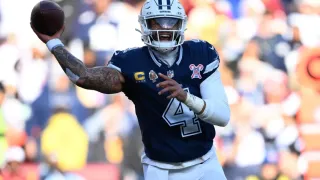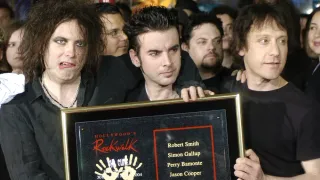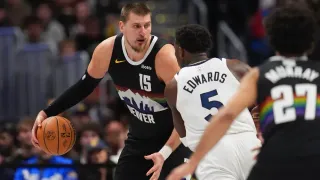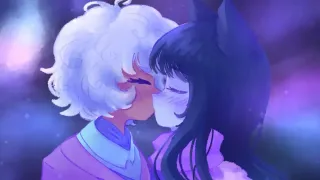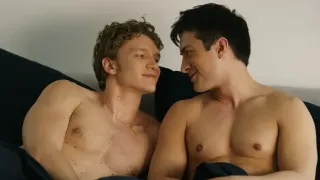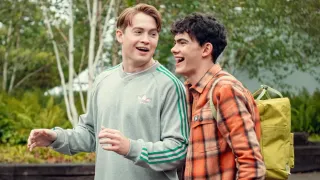October 19, 2014
Queer Comics: A Few of Comic Books' More Groundbreaking LGBT Characters
Kilian Melloy READ TIME: 4 MIN.
1. Kevin Keller
The sagging fortunes of Archie Comics changed dramatically in September 2010 when Kevin Keller moved to Riverdale in Veronica #202. First introduced in 1941, Archie was, for more than fifty years, a peak inside the lives of all American small town teenagers. By the turn of the 21st Century, the formula had grown stale. Archie and the gang seemed out of place in our post-Obama, marriage equality world.
Veronica quickly fell in love with Kevin, the blonde and pretty new boy in town. Kevin quickly told Jughead that he had no interest in Veronica because he's gay. The revelation made front-page news in the real world, but to the teens at Riverdale High it was no big deal. Kevin has since starred in his own ongoing mini-series and was prominently featured in the Life With Archie books, which speculated as to what the characters adult lives might be. Kevin's "Life With Archie" wedding was the fastest selling Archie comic in decades.
Although certainly not the first gay comic book character, Kevin Keller is perhaps the most groundbreaking. For changing the fortunes of an iconic franchise that had seen better days but has since bounced back, Kevin gets the number one spot.
2. Batman and Robin
Are the Caped Crusader and Boy Wonder an item or aren't they? People have been arguing that point for decades. The answer depends on who you ask, and which incarnation of the boys you're reading or watching.
The facts are simple: Bruce Wayne and Dick Grayson, two men who show little interest in allowing women into their lives, live together in a beautiful, antique filled mansion. They are absolutely devoted to each other. You do the math.
The 1943 movie serial Batman presents the boys as having no interest whatsoever in women, even as reporter Vicki Vale tries in vain to get Bruce's attention. Yet there has been, over the years, an obvious attraction between Batman and The Catwoman. Then there's a 1954 Batman panel, which shows Bruce and Dick waking up in the same bed as Bruce suggests they shower.
Is Batman bisexual? Could be.
The jury is still out on the mysterious sexuality of Batman and Robin.
3. Marcie
Many mistakenly believe that Peppermint Patty and Marcie from Peanuts are a lesbian couple. Look closer. Though they are indeed an inseparable twosome, butch tomboy Patty obviously has a crush on Charlie Brown, whom she calls "Chuck." Marcie, on the other hand, follows Patty around like an obedient puppy, dutifully calling Patty "Sir" at all times.
Marcie's lesbianism has, in fact, been obvious for decades. It's clear, in many Peanuts panels, that Marcie only has eyes for Patty, and this was a very courageous move for Peanuts creator Charles Schulz to make.
Look at the girls closely - don't they kinda look like Charlie Brown in drag? In many interviews, the late Schulz (1922-2000) stated that the Peanuts characters, male and female alike, are variations of himself, and that all the characters were drawn around the same face.
4. Batwoman
Reintroduced in 2006 after being dormant for years, Batwoman's alter-ego, Kate Kane, was revealed to be a lesbian. The character's relaunch was a brand new version of the Batwoman, with no connection to the woman which was often seen in Batman books of decades past until her 1976 disappearance from the franchise. While there have been other gay characters in the LGBT universe, the new Batwoman was the first to star in her own series. She was embraced by readers.
In Batwoman #17, published in 2012, Kate/Batwoman became engaged to her girlfriend Maggie.
Controversy exploded in the Fall of 2013 when Batwoman writers JH Williams and W Haden Blackman resigned from DC Comics amid allegations that they were being forced to drop and/or rewrite story arcs, which included not allowing the ladies to marry. The authors felt that DC was compromising Batwoman's character and the series.
According to a story by Helen Lock of the Telegraph UK, DC claimed that the changes they asked for had nothing to do with the character's sexual orientation, but the writers weren't convinced. They departed after completing issue #26.
5. Green Lantern
In June 2012, DC Comics introduced Earth Two, a new series written by James Robinson and drawn by Nicola Scott. The book's premise was the relaunch of a concept the comic book company had done before: Parallel worlds in which different versions of heroes such as Superman, The Flash and Green Lantern led lives which differed considerably from their established histories.
When first seen in issue #2 of the new series, Alan Scott, AKA Green Lantern, is presented as an out gay man. "He doesn't come out, he's already a gay man," James Robinson told CNN. "Alan Scott is super-heroic, super gallant, he'll die for the Earth, he'll die for its people, he's everything you want in a hero. I imagine he's such a type-A character that when he realized he was gay he was like, 'OK, I'm gay, now I'm just gonna go on with my life.' "
As she developed the character's look, Nicola Scott told CNN that Alan "had to be a big, strapping handsome man that everyone would instinctively follow and love."
Sounds like our kind of guy.
6. Northstar
A Canadian super hero, openly gay Northstar, made history when he married his partner Kyle Jinadu in "Amazing X Men" #51, published June 27, 2012.
Introduced onto the Marvel Comics canvas in 1979, Northstar came out in 1992, after a proposed storyline in which he was revealed to have AIDS was rejected.
Instead, the character's alter-ego Jean Paul adopts a baby girl who's dying of AIDS. Her death a few weeks later inspires his coming out in the hope that his celebrity will increase public awareness of HIV awareness.
When Northstar and Kyle tied the knot, right wing media watchdog group One Million Moms staged one of their many failed boycotts.
7. Alysia Yeoh
The unthinkable happened in Batgirl #19, published in April 2013. Alysia Yeoh, roommate to Barbara Gordon (Batgirl) reveals that she is a bisexual transwoman -- this was the first trans character in a mainstream comic book. Done with sensitivity, Batgirl writer Gail Simone was careful to differentiate between Alysia's sexual and gender identities. Alysia is also Asian.
Historic indeed.
 Copyright South Florida Gay News. For more articles, visit
Copyright South Florida Gay News. For more articles, visit 